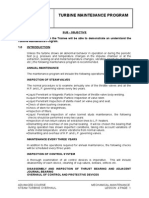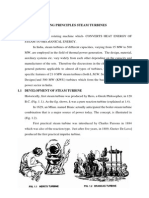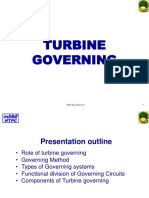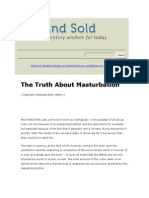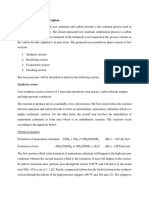3-1 Operation of Cooling Towers
Uploaded by
Hassan Sami3-1 Operation of Cooling Towers
Uploaded by
Hassan Sami3-1 OPERATION OF COOLING TOWERS:
Mechanical draft towers utilize large fans to force or suck air through
circulated water. The water falls downward over fill surfaces, which help
increase the contact time between the water and the air - this helps
maximise heat transfer between the two. Cooling rates of Mechanical
draft towers depend upon their fan diameter and speed of operation. [1]
3-1-1Cooling Tower (Supply) Basin
Water is supplied from the discharge of the Circulating Water System to
a Distribution Basin, from which the Cooling Tower Pumps take a
suction.
3-1-2Cooling Tower Pumps
These large pumps supply water at over 100,000 gallons per minute to
one or more Cooling Towers. Each pump is usually over 15 feet deep.
The motor assembly may be 8 to 10 feet high. The total electrical
demand of all the Cooling Tower pumps may be as much as 5% of the
electrical output of the station. [2]
Its need high current to start up for that the priority in operation to it.
3-1-3 Cooling Tower Performance
The important parameters, from the point of determining the
performance of cooling towers, are :
Fig (3-1): Range and Approach
i) Range is the difference between the cooling tower water inlet and
outlet temperature. (See Figure3-1 (
ii) Approach is the difference between the cooling tower outlet cold
water temperature and ambient wet bulb temperature. Although, both
range and approach should be monitored, the `Approach is a better
indicator of cooling tower performance. (See Figure 3-1)
iii) Cooling tower effectiveness (in percentage) is the ratio of range, to
the ideal range, i.e., difference between cooling water inlet temperature
and ambient wet bulb temperature, or in other words it is = Range /
(Range + Approach).
iv) Cooling capacity is the heat rejected in kCal/hr or TR, given as product
of mass flow rate of water, specific heat and temperature difference .[3]
Figure 3-1 Range and Approach
3-1-4Start--Up of Idle Cooling Towers:
Stagnant Water laying in a cooling tower sump and/or its associated
piping can develop high levels of bacteria during extended idle periods.
To reduce the risk from legionellosis*,Legionella Pneumophila , we
recommend following these guidelines whenever a cooling tower system
is started up for the season or after a prolonged idle period (ten days or
more):
1. Chemical Additions should be made 24 hours prior to the system
being put on line.
2. Remove heat load from the cooling system, if possible.
3. Shut off cooling tower fans during chemical circulation.
4. Unplug the tower bleed solenoid valve. Keep makeup water valves
open and operating.
5. Close building air intake vents in the vicinity of the cooling tower
(especially those'd own wind) until after the cleaning procedure is
complete.
6. Continue to operate the recirculating water pumps.
7. After adding treatment (products listed below), circulate the loop
for a few hours, or enough time to effectively distribute the
biocide. After circulation, the pump can be shut down.
8. After 24 hours of operation the tower bleed valve can be plugged
back into the controller. [4]
3-2 Turbine oil circuits:
The oil circuits play an especially important role in the lubrication of
power station. Steam turbines are normally fitted with pressurized oil
circuits and separate lubricating and control circuits as well as separate
lubricating and control oil tanks are used. In normal operating conditions
the turbine shaft driven main oil pump draws oil from the tank into the
control and bearing supply circuits. Pressure in control circuits is
normally between 10 and 40 bar. Oil tanks temperature ranges from 40
to 60 .cooled and passing through the reduction valves, the oil reaches
the turbine generator and possible gearbox bearing at a pressure of (1-3)
bar. The individual oil feeds return to the oil tank at atmospheric
pressure. [5] Lack of lubricant or contaminated lubricant could result in
bearing failure. This could create sparks or hot surfaces which could
ignite lubricant or flammable gasses. [6]
During the normal operation of the turboset, all the required oil is
supplied by the main oil pump, (centrifugal single-stage type (MOP)]
whose impeller is directly mounted on the HP rotor of the turbine.
During Standstill of the turbine and during starting and stopping of the
set, the oil is supplied by means of one of the two starting oil pumps.
These pumps are immersed in the oil tank and are driven by motors
located at 8 m level. They are started manually after the valves on the
delivery of the pump are kept opened. [7]
The jacking oil pump for lifting of the rotors consists of one driving
motor with three numbers of single flow gear pumps and two numbers
of duplex type. For the front and rear HP bearings one pump supplies
the oil and each of the other pumps supply oil to the individual bearings.
The last pump gives the impulse oil for putting the turning gear into
operation. Each pump has its own relief valve which opens at an
increase of pressure to 70 atm. On the pipe line for this high pressure oil,
non-return ball valves are mounted just in front of the bearings, to
prevent the back flow of oil from the bearings when the jacking oil pump
is not running. Before putting the lifting oil pump into operation, it is
necessary to ensure sufficient pressure of lubricating oil so that these
pumps do not run dry, and get seized. [7]
3.3 Feed pump
3.3.1 System Startup
Boiler Feed Pumps 1, 2, 4 and 5
1. On the feed water pump DCS control, for the pump you are going to
start, check that the Manual/Automatic control station for the feed
water recirculation control valve is on Manual and 100 percent open.
[8]
2. Be sure the upstream and downstream stop valves in the recirculation
line are open and all of the stop valves for the Boiler Feed Pumps are to
remain open at all times. [9]
3. On the pump you are going to start:
a. Be sure the pump suction and discharge valves are open.
b. Open the pump vent valves to be sure all air is out, and continue to
vent water until pump has warmed to DA water temperature. Close vent
valves.
c. Check the oil level of the pump and motor bearings,
d. Adjust cooling (city) water to pump bearing oil coolers for proper
flow. [8]
4. If starting Boiler Feedwater Pump No. 1 and/or No. 2
a. On the feed water pump control screen, start the pump.
b. Immediately check the pump and motor bearing oil rings.
c. Put the pump feed water recirculation Manual/Automatic control to
Automatic. [8]
5. If starting Boiler Feedwater Pump No. 4 and/or No. 5,
a. At the pump, press the pump "Start" pushbutton. The pump will
start and pump discharge pressure will increase to about 600 to 700
psi.
b. Immediately check the pump and motor bearing oil rings.
c. Check pump gland seal leak off.
d. On the feed water pump control panel,
1). The indicator will show the pump flow in thousand pounds per
hour.
2). Match the circuit breaker control switch flag to the indicating
light by turning the switch to the "Start" position. This will also
energize the annunciator circuit for this pump.
e. Put the pump feed water recirculation in Automatic [9]
NOTE: Boiler Feedwater Pump No. 3 is now in stand-by service, and will
automatically start if our feed water header pressure drops too low. The
steam control valve for this pump has an orifice line around it
continually allowing a small amount of steam to enter the turbine. This
keeps the turbine hot and ready for automatic operation. [9]
Boiler Feedwater Pump No. 3
6. In case of a failure, or overloading, of our motor driven feed water
pumps in service, the following sequence of events will occur.
a. Boiler Feedwater Pump No. 3 will continue to run until the feed water
pressure has been regained with your motor driven feed water pumps,
and you manually reset Boiler Feedwater Pump No. 3.
7. To reset Boiler Feed Pump No. 3
a. Be sure you have enough motor driven feed water pumps in service
to carry the steam load.
b. Manually lift up on the Manual Reset lever until it latches. The steam
control valve will close and the pump will shut down
3.3.2 In Normal Operation
1. Check Boiler Feed Pumps oil levels and temperatures.
2. Check boiler Feed Pumps cooling water.
3. Check Boiler Feed Pumps for abnormal noise and vibration.
4. Check Feed water Regulators for proper operation and air leaks.
5. Monitor Feed water System temperatures, pressures, flows and
levels.
[9]
Boiler Startup:
A. Boiler start up follows after all systems have been properly checked
(visually, hands on, and electronic systems check) for proper
operation and assures that safety devices are in propper working
order.
1. Check water level in sight glass and assure water supply to boiler,
fill the proper level (s) as required.
2. On the steam boiler, a vent or test valve is supplied to vent excess
air when filling the boiler. Leave the valve open until steam
appears , then close it
3. Check all settings on operating controls.
4. Check all rest and lock out mechanisms.
5. Close supply valve to distribution header.
6. On combination fuel units, set fuel selecter switch to primary fuel
to be used.
7. Turn burner switch to On.
Blower motor will energize to purge combustion chamber in the
pre-purge period and continues to run
Damper Closes
Automatic igniter lights off boiler in Lowe fire. Boiler continues to
rum in low fire until properly warmed up before burner is allowed
to go into high fire. [13]
Bringing the Boiler on Load:
In bringing a boiler on load the key parameter to be maintained is
temperature and its not maintained constant but is changed according to
a predetermined pattern. This pattern is a compromise between the desire
to bring the boiler on load as quickly as possible and the risk of boiler
damage by thermal stresses arising.
The stages of Bringing boiler on load:
1- Warming up before circulation is established :
Here the limit on the system is the temperature of boiler tubes.
Until circulation is established there is a risk of local overheating in
regions of pockets of trapped steam and of serious uneven heating
between adjacent tubes. Limited input of energy into the system is
needed and light oil burners are used.
The provision of boiler circulating pumps removes this stage from
procedure. [14]
2- Warming up after circulating is established :
Here the main concern is stresses on the boiler drum arising from
uneven heating along its length or through the thickness of its
metal.
These limitations are met by restricting the permissible rate of rise
of drum pressure and hence of drum temperatures. Progressively
more energy is taken from system by steam flow to drains and
slightly tighter input is needed. The control of energy input is
achieved by varying the number of oil burners if applicable. [14]
3- Stage when significant quantities of steam are being taken :
1. This stage is present when boilers used for industrial processes are
also used to generate power, and then turbine conditions must
match with steam output conditions.
2. The limit now passes to the maximum permissible value in the
superheater tube metal temperatures.
3. The system and fuel flows are increasing since appreciable energy
is being taken from the system.
4. Considerable drainage on the in the superheater may still be
necessary. [14]
4- Bringing the boiler on load :
1. Here the limit is still the superheater temperature. During this stage
there must be change from the light oil used in the initial stages to
the heavy fuel oil. The sequential ignition of these burners provides
the fine control of the energy needed.
2. As each burner is put into service, care must be taken to see if it
ignites properly, and that burns with bright smokeless flame. [14]
3-4 Steam Turbine:
Steam turbine operation and performance require ensuring proper
steam quality is delivered to the turbine and a proper expansion
compensation. Also we need to ensure supply and exhaust line are sized
properly. Steam piping needs to be properly supported. [10]
3-4-1 Steam Quality
Steam must be of the highest quality (steam without condensate
entrapment) and for this purpose the steam supply lines and
components (valves, casing, etc) should be insulated to prevent steam
from releasing latent energy which causes condensation to occur in the
steam system.
All steam supply lines must be properly designed with appropriate
condensate removal components including correctly sized steam line
drip pockets and steam trap stations. [10]
3-4-2 Steam Piping
The steam piping should be reviewed, analyzed, designed, and properly
installed to ensure there will be no excessive forces transmitted to the
turbine flanges. Steam piping may exert forces from four sources:
1. Pipe dead weight
2. Thermal expansion
3. Thrust
4. The spring rate caused by different types of expansion joints.
[10]
3-5 Starting the Condenser
Start the condenser in advance of the turbine and any other equipment
that exhausts into the condenser according to the following procedure:
1. Check all atmospheric vent valves on the shell side (steam side) of the
condenser to make sure they are closed. Make sure the atmospheric
relief valve is operable and properly sealed with water.
2. Check to insure that all water box vent valves on the tube side (water
side) are open to bleed the system of air.
3. Slowly open the isolating valves in the main condenser circulating
water line(s) to permit flow through the unit. The circulating water
pump(s) should be running at this time. When water flows from the
water box vent lines, they should be closed. It is important to make sure
the condenser water boxes remain completely full of water. [11]
4. Check the hot well water level. This should be approximately midway
in the hot well gauge glass. Refer to the setting plan drawing supplied for
specific details. (When starting the condenser for the first time, fresh
water will need to be introduced into the hot well to obtain a starting
level and to prime the condensate pump system.)
5. If condensate is being used as a cooling medium in the vacuum
venting equipment, open the valve in the condensate recirculation line
to the recycle startup connection located in the upper half of the
condenser shell and close the valve to the recycle connection in the hot
well. After the unit is started and the steam turbine is running, switch
back to the recycle connection in the hot well. If raw water is being used,
no change is required in the recycle line. Slowly open the water supply
line and verify that water is flowing through the vacuum venting
equipment. [11]
6. Start the condensate pump. Check to insure that the automatic level
controls are maintaining the hot well water level. The normal level will
be shown on the drawing supplied. As a general guideline, the level
should be halfway up the hot well gauge glass. [11]
7. Start the vacuum venting or hogging equipment. If hogging equipment
is supplied it should be started first. Its purpose is to rapidly evacuate
the condenser and associated piping (including the turbine casing) in a
short period of time (usually 30 to 60 minutes).
8. When the proper vacuum has been achieved start the steam turbine.
[11]
3-6 FEEDWATER HEATER COLD STARTUP
1. At cold startup the extraction steam supply valve should initially be
closed. The shell side and tube side drain valves are closed. The shell
side startup and operating vent are closed. [12]
2. If the heater has been charged with nitrogen gas, the nitrogen supply
valve is shut off.
3. Feedwater is gradually introduced so that the channel can warm up.
If the channel has not been kept completely full of water, then the
channel vent valves should be opened long enough to purge out the
air.
4. Operating vent line drain should be opened long enough to allow any
collected moisture to escape. The shell side startup vent valves are
openedthere may be several of these. Then the operating vent
valves are opened. If there is a bypass loop around the vent orifice,
the valves in this loop should be closed. [12]
5. If the heater is vertical channel down and there are continuous
drains at the bottom of the desuperheating zone, these are opened.
6. Isolation valves to the liquid level indicator and other
instrumentation connections are opened
7. Make sure that the emergency drain valve, if present, is closed and
the normal drain shutoff valve is open. [12]
8. The steam supply valves (extraction steam and/or flash tank startup
steam) are then gradually opened. If multiple heaters are involved,
then the heater with the lowest shell side pressure should receive
steam first.
9. The liquid level should be observed closely during startup. For
heaters operating at relatively low pressures, it is possible that there
may be some difficulty in maintaining the desired liquid level at low
loads. In such a case, it will be helpful to temporarily open the
emergency drain nozzle, if present. [12]
References:
1. http://www.em-ea.org/Guide%20Books/book-
3/Chapter%203.7%20Cooling%20Tower.pdf
2. http://www.nucleartourist.com/systems/ct.htm
3. Perrys Chemical Engineers Handbook (Page: 12-17)
4. www.proasysinc.com
5. Lubricants and lubrication edited by Theo Mang
6. RLA Turbine Instruction manual
7. 110 MW steam turbine Manual
8. Byron Jackson General Electric
9. https://www.google.com/url?sa=t&rct=j&q=&esrc=s&source=we
b&cd=2&cad=rja&ved=0CDoQFjAB&url=https%3A%2F%2Fcantea
ch.candu.org%2FContent%2520Library%2F19930205.pdf&ei=pnC
lUqrVM8nxygPNn4GIAg&usg=AFQjCNGOAo0UIFSkWIs9XRAmk70
enbCyKA&bvm=bv.57752919,d.bGQ
10. Sakegelok Energy Advisors - Steam systems Best practice
11. Surface Condenser Operation Maintenance and Installation
Manual - Graham Corporation
12. http://heatexchange.org/pdf/techsheets/TechSheet128.pdf
13. http://www.scribd.com/doc/138074680/Boilers-Operation
14. http://www.readbag.com/alexeng-eg-mech-sorourm-ch11
You might also like
- Reference - Beach-Russ Vacuum Pump Operation100% (2)Reference - Beach-Russ Vacuum Pump Operation2 pages
- Machinery Vibration Signals Analysis and Monitoring For Fault Diagnosis and Process Control PDFNo ratings yetMachinery Vibration Signals Analysis and Monitoring For Fault Diagnosis and Process Control PDF8 pages
- Scanned Manual: Cooper Nuclear Station Vendor Manual Mfr. Byron Jackson Pump DivisionNo ratings yetScanned Manual: Cooper Nuclear Station Vendor Manual Mfr. Byron Jackson Pump Division77 pages
- Condition Monitoring of Steam Turbines by Performance Analysis - R Beebe100% (2)Condition Monitoring of Steam Turbines by Performance Analysis - R Beebe11 pages
- Calculation of Overspeed Trip Mechanism Linkage ForcesNo ratings yetCalculation of Overspeed Trip Mechanism Linkage Forces34 pages
- Cation Conductivity Monitoring: A Reality CheckNo ratings yetCation Conductivity Monitoring: A Reality Check7 pages
- Reading Coal Flame in Tangentially Fired BoilerNo ratings yetReading Coal Flame in Tangentially Fired Boiler4 pages
- Report #1: Alternating-Current Project: Steam-Electric Power Plant100% (1)Report #1: Alternating-Current Project: Steam-Electric Power Plant41 pages
- CW Pumps Tripping On Over Load, 210 MW Unit, 02-03No ratings yetCW Pumps Tripping On Over Load, 210 MW Unit, 02-035 pages
- Frequency Control and AGC Final 2012-PresentationNo ratings yetFrequency Control and AGC Final 2012-Presentation24 pages
- Module 8 - Energy Performance Assessment of BoilersNo ratings yetModule 8 - Energy Performance Assessment of Boilers24 pages
- Measurement of PH Using Cationic Conductivity in Power Plants100% (3)Measurement of PH Using Cationic Conductivity in Power Plants4 pages
- Technologies For High Performance and Reliability of Geothermal Power Plant100% (1)Technologies For High Performance and Reliability of Geothermal Power Plant4 pages
- Simplified - Field - Balancing - One Correction Plane or TwoNo ratings yetSimplified - Field - Balancing - One Correction Plane or Two11 pages
- 2013 Brochure Modernizations Upgrades Steam Turbines enNo ratings yet2013 Brochure Modernizations Upgrades Steam Turbines en16 pages
- Importance of Three-Elements Boiler Drum Level Control and Its Installation in Power PlantNo ratings yetImportance of Three-Elements Boiler Drum Level Control and Its Installation in Power Plant12 pages
- PLTU Nagan Raya NAD 2X110MW: Boiler Operation Manual (Startup Boiler Operation Manual) Vol.1 - 4ANo ratings yetPLTU Nagan Raya NAD 2X110MW: Boiler Operation Manual (Startup Boiler Operation Manual) Vol.1 - 4A27 pages
- Rooftops High Performance, Proven Reliability and Easy InstallationNo ratings yetRooftops High Performance, Proven Reliability and Easy Installation12 pages
- USB Microphone Suggestions?: Chak Aw Home Recording Back To Home Recording DiscussionsNo ratings yetUSB Microphone Suggestions?: Chak Aw Home Recording Back To Home Recording Discussions5 pages
- All All 'Number of Cell As X-Dirction (NX) ' 'Number of Cell As Y-Dirction (Ny) ' 'Explicit Let X 1 or Implicit Let X 0'No ratings yetAll All 'Number of Cell As X-Dirction (NX) ' 'Number of Cell As Y-Dirction (Ny) ' 'Explicit Let X 1 or Implicit Let X 0'2 pages
- Hydraulic Calculation For Sprinkler System (Sckho) - REV5 PDFNo ratings yetHydraulic Calculation For Sprinkler System (Sckho) - REV5 PDF1 page
- Taylor Valve Technology, Inc: MC Series Throttling Choke ValveNo ratings yetTaylor Valve Technology, Inc: MC Series Throttling Choke Valve17 pages
- 3.4 Complete Process Description: Synthesis SectionNo ratings yet3.4 Complete Process Description: Synthesis Section3 pages
- Computer Exercise 1 Applied Computational Fluid Dynamics MVK150No ratings yetComputer Exercise 1 Applied Computational Fluid Dynamics MVK1503 pages
- Consideration For Approval of ATU For Use in Trinidad and Tobago100% (1)Consideration For Approval of ATU For Use in Trinidad and Tobago5 pages
- Urea Reactor Designing: Chemical EngineeringNo ratings yetUrea Reactor Designing: Chemical Engineering15 pages
- Instrument Ation, Control and Management of Batch Reactors Using Distributed ControlsNo ratings yetInstrument Ation, Control and Management of Batch Reactors Using Distributed Controls4 pages
- Energy Recovery Devices in Seawater Reverse Osmosis DesalinationNo ratings yetEnergy Recovery Devices in Seawater Reverse Osmosis Desalination123 pages
- Fybecarb: High-Efficiency, Acid-Soluble, Single-Sack Loss-Prevention and Remedial MaterialNo ratings yetFybecarb: High-Efficiency, Acid-Soluble, Single-Sack Loss-Prevention and Remedial Material1 page
- Technological University (Maubin) Department of Mechanical Engineering Mini One Door Refrigerator100% (1)Technological University (Maubin) Department of Mechanical Engineering Mini One Door Refrigerator13 pages
- Machinery Vibration Signals Analysis and Monitoring For Fault Diagnosis and Process Control PDFMachinery Vibration Signals Analysis and Monitoring For Fault Diagnosis and Process Control PDF
- Scanned Manual: Cooper Nuclear Station Vendor Manual Mfr. Byron Jackson Pump DivisionScanned Manual: Cooper Nuclear Station Vendor Manual Mfr. Byron Jackson Pump Division
- Condition Monitoring of Steam Turbines by Performance Analysis - R BeebeCondition Monitoring of Steam Turbines by Performance Analysis - R Beebe
- Calculation of Overspeed Trip Mechanism Linkage ForcesCalculation of Overspeed Trip Mechanism Linkage Forces
- Report #1: Alternating-Current Project: Steam-Electric Power PlantReport #1: Alternating-Current Project: Steam-Electric Power Plant
- CW Pumps Tripping On Over Load, 210 MW Unit, 02-03CW Pumps Tripping On Over Load, 210 MW Unit, 02-03
- Module 8 - Energy Performance Assessment of BoilersModule 8 - Energy Performance Assessment of Boilers
- Measurement of PH Using Cationic Conductivity in Power PlantsMeasurement of PH Using Cationic Conductivity in Power Plants
- Technologies For High Performance and Reliability of Geothermal Power PlantTechnologies For High Performance and Reliability of Geothermal Power Plant
- Simplified - Field - Balancing - One Correction Plane or TwoSimplified - Field - Balancing - One Correction Plane or Two
- 2013 Brochure Modernizations Upgrades Steam Turbines en2013 Brochure Modernizations Upgrades Steam Turbines en
- Importance of Three-Elements Boiler Drum Level Control and Its Installation in Power PlantImportance of Three-Elements Boiler Drum Level Control and Its Installation in Power Plant
- PLTU Nagan Raya NAD 2X110MW: Boiler Operation Manual (Startup Boiler Operation Manual) Vol.1 - 4APLTU Nagan Raya NAD 2X110MW: Boiler Operation Manual (Startup Boiler Operation Manual) Vol.1 - 4A
- Rooftops High Performance, Proven Reliability and Easy InstallationRooftops High Performance, Proven Reliability and Easy Installation
- USB Microphone Suggestions?: Chak Aw Home Recording Back To Home Recording DiscussionsUSB Microphone Suggestions?: Chak Aw Home Recording Back To Home Recording Discussions
- All All 'Number of Cell As X-Dirction (NX) ' 'Number of Cell As Y-Dirction (Ny) ' 'Explicit Let X 1 or Implicit Let X 0'All All 'Number of Cell As X-Dirction (NX) ' 'Number of Cell As Y-Dirction (Ny) ' 'Explicit Let X 1 or Implicit Let X 0'
- Hydraulic Calculation For Sprinkler System (Sckho) - REV5 PDFHydraulic Calculation For Sprinkler System (Sckho) - REV5 PDF
- Taylor Valve Technology, Inc: MC Series Throttling Choke ValveTaylor Valve Technology, Inc: MC Series Throttling Choke Valve
- 3.4 Complete Process Description: Synthesis Section3.4 Complete Process Description: Synthesis Section
- Computer Exercise 1 Applied Computational Fluid Dynamics MVK150Computer Exercise 1 Applied Computational Fluid Dynamics MVK150
- Consideration For Approval of ATU For Use in Trinidad and TobagoConsideration For Approval of ATU For Use in Trinidad and Tobago
- Instrument Ation, Control and Management of Batch Reactors Using Distributed ControlsInstrument Ation, Control and Management of Batch Reactors Using Distributed Controls
- Energy Recovery Devices in Seawater Reverse Osmosis DesalinationEnergy Recovery Devices in Seawater Reverse Osmosis Desalination
- Fybecarb: High-Efficiency, Acid-Soluble, Single-Sack Loss-Prevention and Remedial MaterialFybecarb: High-Efficiency, Acid-Soluble, Single-Sack Loss-Prevention and Remedial Material
- Technological University (Maubin) Department of Mechanical Engineering Mini One Door RefrigeratorTechnological University (Maubin) Department of Mechanical Engineering Mini One Door Refrigerator















